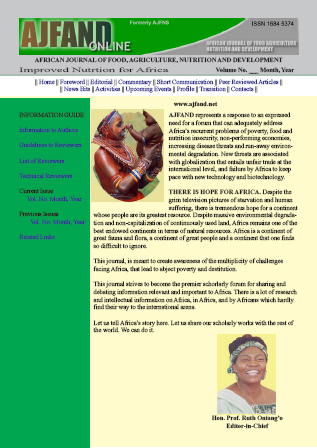
|
African Journal of Food, Agriculture, Nutrition and Development
Rural Outreach Program
ISSN: 1684-5358
EISSN: 1684-5358
Vol. 20, No. 5, 2020, pp. 16540-16562
|
 Bioline Code: nd20088
Bioline Code: nd20088
Full paper language: English
Document type: Research Article
Document available free of charge
|
|
|
African Journal of Food, Agriculture, Nutrition and Development, Vol. 20, No. 5, 2020, pp. 16540-16562
| en |
OVERWEIGHT STATUS AND DIETARY HABIT OF CHILDREN ATTENDING PRIVATE SCHOOLS IN ADO-ODO OTA, SOUTH WESTERN NIGERIA
Anaemene, D & Ogunkunle, M
Abstract
Globally, childhood overweight/obesity has persistently increased over decades and
associated with non-communicable diseases such as type 2 diabetes mellitus,
hypertension and other cardiovascular diseases. However, data on the trend of
overweight/obesity among Nigerian children is limited because surveys have focused
more on under-nutrition problems. This study aimed at determining the prevalence of
overweight/obesity and dietary habits of children attending privately owned schools. A
multi-stage random sampling was employed to select 478 pupils (8-11 years).
Information on socio-demographic characteristics, dietary habit and physical activities
were collected via interviewer administered questionnaire. Weight and height
measurements were taken to determine overweight and obesity status using BMI-forage
(5-19 years) growth chart. Dietary recall was used to determine daily energy/nutrient
intake. The five selected schools were categorized into types 1-4 based on school fees.
On analysis, prevalence rates of 14.7% (overweight), 4.7% (obesity) and 4.3%
(thinness) were observed. The mean weight of pupils from school type 1(29.4 ± 5.4kg)
was statistically different from the mean weights of schools, type 3 (34.0 ± 8.6) and type
4(36.2 ± 8.6kg) at p<0.001. Significant difference existed in the overweight status of the
school children across school types (p=0.002) with school type 4 having the highest
prevalence (29.4%). Children who attend the high fee-paying schools were 1.8 times
more likely to become overweight/obesity than children who attend the moderate fee
schools (OR 1.83; 95% CI (1.08-3.08), p=0.015). The average daily intake of energy of
pupils of school type 4 (2074±310 kcal) and type 1(1807.96±373kcal) differed
significantly (p=0.01). Dietary assessment revealed high consumption of fatty foods and
inadequate intake of vegetable, fruits and milk. More children (40%) watched
television/film followed by 27% who engaged in computer games during their leisure
period. Among school children who attend private schools, greater proportions are
overweight and obese. Higher prevalence of overweight and unhealthy eating habits
were found among school children of type 4 (highest fee) compared to other types.
Appropriate nutritional strategies targeting children from wealthy homes should be
developed.
Keywords
Overweight; dietary assessment; nutritional status; children; anthropometric assessment; private school
|
| |
© Copyright 2020 - African Journal of Food, Agriculture, Nutrition and Development
Alternative site location: http://www.ajfand.net/
|
|
